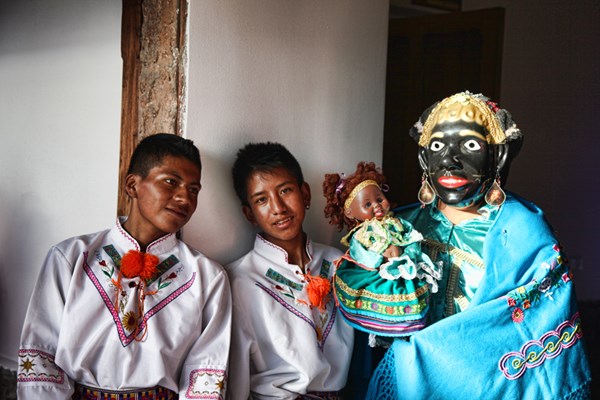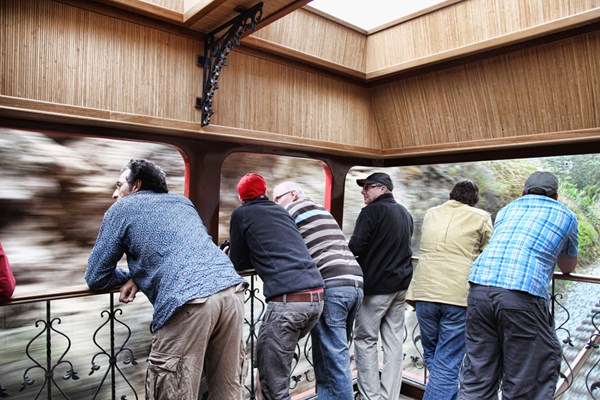QUITO, Ecuador, Aug. 14, 2013 (GLOBE NEWSWIRE) -- Posicionarte, a travel & pr media agency, was invited to discover the brand new Ecuador's cruise train trip 4 days 3 nights from the Andes to Coast, it´s travel editor Andy Taylor travels through time and the Avenue of Volcanoes on a scenic train ride to the Ecuadorian Coast, enjoying colonial, Incan and Pre-Incan cultures.
Andrew says "When I was a boy, I wanted to grow up to become a time lord". "It was all very clear in my mind. I would wear a long purple gown with a floppy hood. I would spin around three times to jump time. I would keep small furry animals in my big white beard. My tardis (my time-ship) in those days was a large cardboard box with a window and curtains. It doubled up as a puppet theatre. Since then, however, my tastes have matured.
Now I want a big red locomotive as my time ship."
Ferrocarrile´s Train Cruise through the Andes occurs in sofa studded style, floor to ceiling windows, a delightful bar and an open air viewing wagon at the rear. There are two retro diner style wagons, furnished in colonial and republican style. The interior is adorned with motifs and accents that provide something of a montage of Ecuadorian culture. The colonial carriage, ivory white with gilted plastering, features cherubic painted faces, inspired by a detail from the pulpit of La Compañía church in Quito. This cathedral of vaingloriousness blends Baroque opulence with mestizo sensibility and leaves you giddy in its golden glory. In the cruise train bar you can sit on swivelling stools, swizzle a cocktail and admire volcanoes.
As I say, the perfect time-ship.
Sprawling on sofas or hanging off the back taking photographs, passengers can wander the train as is their will and take photos. "As for time travel, I don´t even need to spin around three times" Andrew says. Within hours, they´re willing a cloud to move away from Cotopaxi volcano to take the perfect photograph. We lunch with an ex- President´s great grand-daughter in her cosy hacienda home, San Augustine de Callo built around an Incan chapel. Callo was the altar of the God (and volcano) Cotopaxi. From here, every 25 years on New Year´s Eve the moon appears to sit comfortably on the top of the crater, lending the legend its name. Cota is quichua for Neck, Paxi is Mayan for Moon. When the Spanish conquistadores were marching across the Andes dominating the natives, the volcano erupted.
The locals took this as a warning and decided not to resist the invasion, in favour of staying alive. We dine and sleep at a swamp that's rumoured to have been an Incan graveyard. La Cienega is an incredibly evocative historical monument – a colonial hacienda with cloisters, a chapel and a courtyard garden.
Most of the staff are direct descendants of the original servants and if you get up early enough you will see each of them take time out for prayer, genuflecting and kneeling in the church, before preparing your breakfast. There are 34 grand rooms at www.hosterialacienega.com and many of them have open fires. Ask about the ghost in room 17. It is quite spooky. In the living room, with its huge fireplace and comfy sofas, there is a graphic statue of Jesus wounded on the cross. In room 7 there´s a curious painting of maidens holding all corners of a sheet doing the bumps for a devil jester! It´s a huge contrast to our last night´s digs. The Eternal Spring Hacienda has 34 rooms. Here the party is outside by the pool with a salsa band and dancing under the stars.
Throughout the trip our guide, Marie del Carmen Garces, talks us through the history of each location and how the train line changed the lives of their communities. The highlands of Ecuador are still significantly remote and isolated. Back in the early 1900s, however, this newly independent nation had a huge infrastructure deficit. The only way of getting from the highlands to the coast was by a path so dangerous that people wrote a will before attempting it. The train line was a leap of faith in the construction and took over fifty years to finish. It opened the world for Ecuadorian trade at the time, although still very few people in the country travel much. Eventually, after the Chanchán river flooded taking out the line, Peruvian bombings during the war and landslides – the train line deteriorated. The current government of Raphael Correa took the risk to invest in restoring it for tourists and I really hope it pays off for them.
On the second day, they arrive at Urbina station, an isolated post at 3609m and chat to Balthazar Ushca Tenezaca (79) who gives them an account of his own history. He´s the Last Iceman of Chimborazo Volcano. He tells them how twice a week he climbs up to the glacier (praying) with a donkey and returns with glacial ice. Nowadays, only two markets will buy the ice given the competition that refrigerators provide. His face is full of life, his teeth yellowed but his spirit is untarnished. Back in the day, he was part of an ice mining industry, a trade that owed much to the train line that carried the ice down to the coast to use as refrigeration. As a young man the glacier was in comfortable walking distance of his village, whereas now it´s an eight hour climb. Scientists speculate that the Chimborazo glacier will have completely disappeared in fifteen to twenty years. The glacial streams feed rivers that feed the Amazon.
The deeper they move into the remote Andes, the population is 60% indigenous. At Guamote market, they get the chance to walk around folk who´s lives really haven´t changed much for thousands of years. It´s a local trade market with people selling everything from pigs and sheep to rope, clothes and vegetables. The modesty of people´s lives is really striking. Something in their eyes is deeply saddening.
The last day they visited a Shuar community who treat them to a warrior dance, a Shamanic healing and a ritual to cast out evil spirits. Then our time ship sails straight down the central reservation of an enormous shopping high street (San Raphael.) The traffic grinds to a halt, horns are tooting, sirens are wailing and people everywhere are gawping and waving at us in our big red train. From the viewing terrace at the back it's wonderful to hang out and wave back. One feels positively regal. Adrew finishes saying "I have been travelling through the Andes on a train. I am indeed, a time lord, and the people simply adore me."
Photos accompanying this release are available at:
http://www.globenewswire.com/newsroom/prs/?pkgid=20497
http://www.globenewswire.com/newsroom/prs/?pkgid=20498

